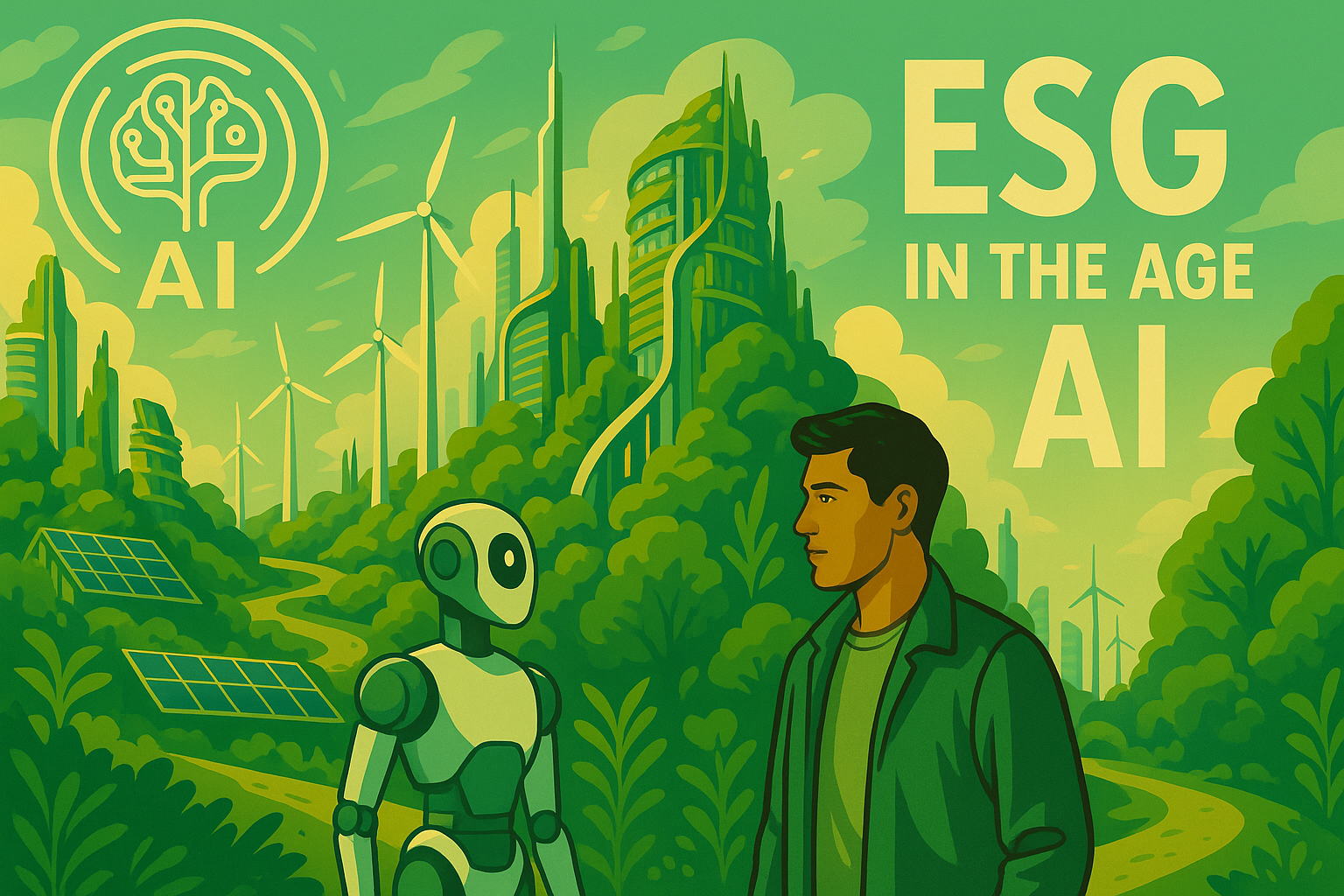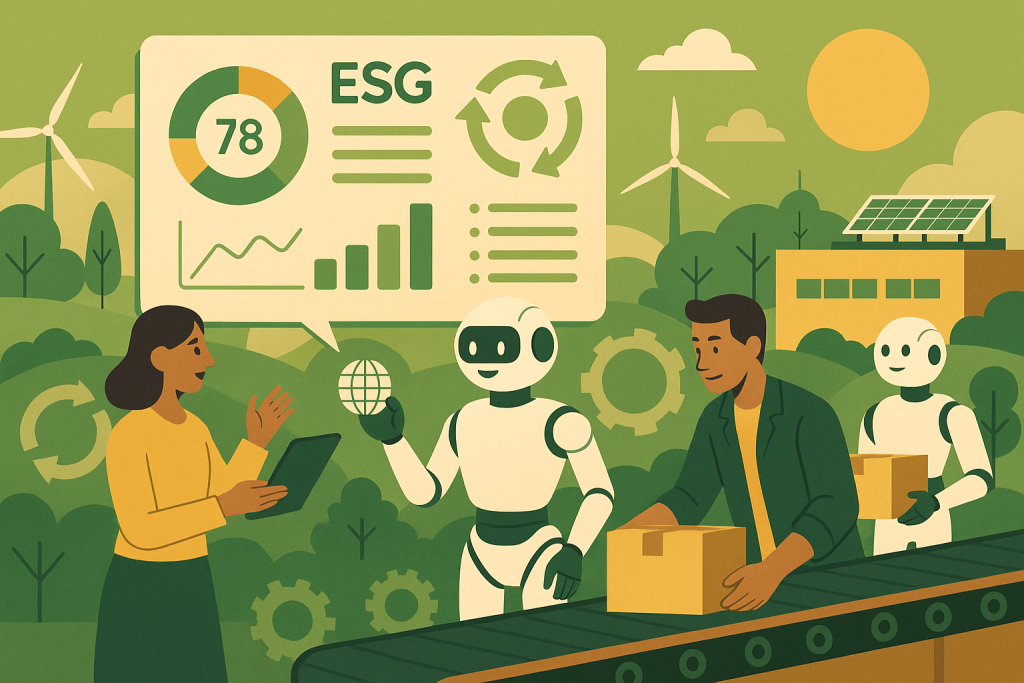Introduction
We’re entering a new phase in the ESG journey—one shaped by artificial intelligence. As ESG frameworks evolve under the pressure of global regulations and public scrutiny, AI is no longer a back-office analytics tool. It’s a strategic driver. But with great power comes even greater expectations around governance, accountability, and trust.
This post explores how AI is reshaping ESG—from carbon tracking to ethical AI design—and why companies must embed sustainability into the very fabric of their AI strategies.
ESG and AI: Two Sides of the Same Coin
At first glance, ESG and AI might seem like separate domains. ESG is about environmental and social responsibility. AI is about efficiency, automation, and prediction.
But in reality, they’re deeply intertwined:
- AI can accelerate ESG: Through real-time emissions monitoring, predictive risk models, and automated supply chain due diligence.
- ESG is essential to responsible AI: Because how you develop, train, and govern AI systems reflects your company’s social and ethical values.
As KPMG puts it: “AI is both a tool to meet ESG goals and a subject of ESG scrutiny.”
Key ESG Impacts of AI
1. Environmental Intelligence at Scale
AI enables new levels of visibility into emissions and resource use:
- Satellite and IoT data fused by AI can map carbon hotspots in supply chains.
- Generative models simulate environmental scenarios for better resilience planning.
- AI optimizes energy consumption across data centers, fleets, and factories.
💡 Real-world example: Microsoft’s AI-powered Sustainability Cloud tracks Scope 1–3 emissions with near real-time granularity.
2. Social Responsibility in the Age of Automation
AI’s power to reshape labor markets, decision-making, and bias requires strong social governance:
- Fairness audits, explainability, and human-in-the-loop frameworks are now core ESG pillars.
- Companies must monitor algorithmic bias and ensure inclusive datasets.
- Job displacement risks from automation must be addressed with upskilling and just transition plans.
3. Governance for Ethical AI
AI governance is emerging as a new ESG vertical:
- Boards are under pressure to oversee AI ethics and risk—not just compliance.
- AI-related incidents (e.g., hallucinations, bias, IP violations) are already triggering shareholder and regulator responses.
- Regulatory regimes like the EU AI Act, CSRD, and DSA intertwine AI and ESG disclosure mandates.
🧭 TL;DR: Good AI governance is ESG governance.
The Trust Gap: Why It Matters
One of the most cited insights from the KPMG report: Only 6% of surveyed organizations fully trust the output of generative AI.
That’s a trust chasm—especially in sustainability, where AI-driven reporting is used in assurance, carbon trading, and investment decisions.
Trust in AI systems must be earned through:
- Transparent data sources
- Validated models
- Auditable workflows
- Clear human accountability
Otherwise, companies risk undermining their ESG credibility with unexplainable or ungoverned AI outputs.
The Path Forward: AI + ESG by Design
To truly align AI with ESG goals, organizations need to move beyond tools and into AI-by-design governance:
| ESG Pillar | AI Integration Opportunity | AI Risk Area |
|---|---|---|
| Environmental | Emissions prediction, optimization | Energy use, greenwashing |
| Social | Diversity audits, hiring fairness | Bias, labor impact |
| Governance | AI ethics boards, transparency dashboards | Compliance failure, AI drift |
This shift demands:
- Cross-functional alignment between sustainability officers, data scientists, and legal teams.
- Proactive AI impact assessments—before deployment.
- ESG disclosures that include AI governance metrics.
FAQ: ESG + AI
Q1: Can AI automate ESG reporting?
Yes, especially for GHG data, supply chain tracing, and regulatory alignment. But human validation remains essential.
Q2: Is AI itself an ESG risk?
Absolutely. Unchecked AI systems can create environmental burdens, social inequality, and governance failures.
Q3: What frameworks help govern AI through an ESG lens?
The EU AI Act, GRI Standards, CSRD, and emerging AI assurance standards (like those from ISO and IEEE) offer a foundation.
Q4: Should companies report on AI ethics in ESG reports?
Yes. Increasingly, stakeholders demand disclosures on how companies develop, govern, and audit their AI systems.
Q5: How can companies prepare for AI + ESG convergence?
By embedding AI risk and ethics into their sustainability strategy and ensuring C-level ownership of AI governance.
Final Thoughts
AI is not just a tool for sustainability—it’s a test of it.
The companies that succeed will be those that embed ESG values directly into their AI systems. Not just for compliance, but for trust, impact, and long-term resilience.
Sustainability in the age of AI isn’t about using AI to do ESG—it’s about doing ESG with AI principles in mind.
📚 Sources Cited
- KPMG (2024). ESG in the Age of AI
Download PDF



